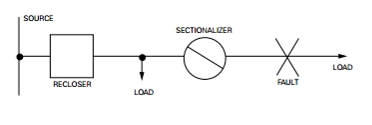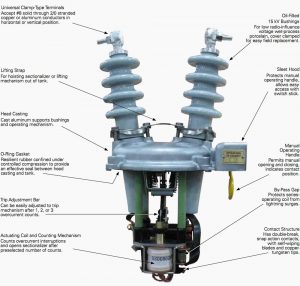Home › Electrical Engineering Forum › General Discussion › How to select a sectionalizer
- This topic has 0 replies, 1 voice, and was last updated 9 years ago by
admin.
-
AuthorPosts
-
2016/02/15 at 10:31 am #11294
admin
KeymasterLast day, A.N. one of our contributors told us how to select an Automatic Transfer Switch (ATS). Now, here he’s back to give us some knowledge about selecting a selectionizer.
If one of you want to share knowledge with the community to keep it alive, just send us a mail!
Introduction
Sectionizers are protective devices that are used in medium voltage distribution systems to automatically isolate faulted sections once an upstream recloser or breaker has interrupted the fault current. The self contained protective devices are usually installed downstream of a recloser in the distribution circuit.
The Sectionizers do not have the capacity to break the fault current and are usually used in conjunction with other backup devices such as reclosers and circuit breakers that have the ability of breaking the fault current. When in operation, the sectionalizer counts the number of interruptions occurring on the circuit. It does this by monitoring the number of times the recloser opens.
[caption id="attachment_9898" align="aligncenter" width="372"]
Figure 1 : Typical sectionalizer connection[/caption]
Once the number reaches a preselected value and with recloser still in the open position, the sectionalizer opens hence isolating the faulty circuit. Once the faulty circuit is isolated, the recloser closes and re-establishes the normal supply to the other circuits with no fault conditions. The devices provide an economical way of isolating sections having permanent faults and confines the outages to these small sections while allowing healthy circuits to continue functioning.
Factors considered when selecting a sectionalizer
There are different kinds of sectionalizers based on their mode of operation, ratings and capabilities. Some of the important factors to consider when selecting a sectionalizer for a certain application are as highlighted below.
- Phase: Single phase or three phase constructions depending on the supply: The single-phase sectionalizer protects the single-phase circuits such as the taps or branches of a three-phase feeder. Typical three-phase sectionalizers open all the three phases simultaneously. This can be due to a phase or ground fault.
- Operating mechanism: the commonly used sectionalizers have either hydraulic or electronics operated mechanism. The hydraulic contacts are opened by a pre-tensioned springs. Most of these sectionalizers have the provisions for manual opening and closing using a hook stick (figure 2). The electronic controlled mechanisms are more flexible and easier to set compared to the hydraulic mechanism. They have both manual and automatic motor controlled opening and closing options.
- The system voltage and current: The sectionalizer voltage and current rating should be equal or greater than the maximum voltage and load current at the point where it is installed.
- Maximum short-circuit capacity: this should be greater or equal to the fault current level at the point of installation.
- How to coordinate with other protection devices that have been installed upstream and downstream. These include the number of operations of the associated breaker or recloser, as well as the starting current setting.
- Sensitivity and ability to discriminate permanent and temporary faults. Sectionalizers are required to automatically disconnect and isolate faulted sections of a distribution network whenever a permanent fault occurs. But if the faults are temporary the sectionalizer does not disconnect, instead the upstream breaker or recloser is required to clear the fault without interrupting the circuit.
- Configurable options such as the actuating current, number of cycles, and other factors that help to obtain the desired combination for the distribution circuit protection.
- Ability to detect and discriminate the inrush currents. This avoids disconnecting the lines due to temporary inrush currents along the circuit.
- Field configuration, resetting options and whether it has remote operation capability. Some systems can be connected to communication systems to allow the operators to control the devices remotely from a control center.
[caption id="attachment_9899" align="aligncenter" width="300"]
Figure 2: GH hydraulically controlled sectionalizer: image cooperpower | CLICK TO ENLARGE[/caption]
Conclusion
Sectionalizers are simple, flexible, convenient, safe and economical means of isolating faulty circuits. There are available in different operating modes, capacity and functionalities, and most of them can be configured to the desired number of counts as well as the amount of actuating current.
Since different applications are unique in one way or another it is important to select the sectionalizer that address the needs of that particular installation and use this with the appropriate protection devices. This ensures the best level of protection that allows other healthy circuits to continue with their normal operations.
-
AuthorPosts
- You must be logged in to reply to this topic.
 Figure 1 : Typical sectionalizer connection[/caption]
Figure 1 : Typical sectionalizer connection[/caption]